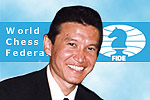| Handbook | C. General Rules and
Recommendations for Tournaments | 02. Standards of Chess Equipment for
FIDE Tournaments
02. Standards of Chess Equipment for FIDE Tournaments
|
Standards of Chess Equipment for FIDE
Tournaments
Approved by the 1975 Central Committee
This document defines the general standards for chess equipment
to be used in FIDE competitions. |
| 1. |
The chess pieces used in matches between two players must be
approved by both. Their approval shall be obtained for other equipment - the
chess table, board and clock.
In case either side disagrees, the equipment to be used shall
be decided by the Chief Arbiter of the match, bearing in mind the standards for
its size and form as mentioned below. |
|
1.1 |
The chess equipment offered by the organisers (hosts) of a
competition within the FIDE system of tournaments, Olympiads and other
competitions shall conform with the standards mentioned below, and shall be
approved by the Chief Arbiter. |
| 2. |
Chess Pieces |
|
2.1 |
Material
Chess pieces should be made of wood, plastic or an imitation of
these materials. |
|
2.2 |
Height, weight, proportions
The King's height should be 8.5 to 10.5 cm. The diameter of the
King's base should measure 40 to 50% of its height.
The size of the other pieces should be proportionate to their
height and form; other elements such as stability, aesthetic considerations
etc., may also be taken into account.
The weight of the pieces should be suitable for comfortable
moving and stability. |
|
2.3 |
Form, style of make
Recommended for use in FIDE competitions are those types of
chess sets and equipment, which have already been used in Men's Olympiads,
interzonal tournaments, candidates' matches and tournaments, and world
championship matches.
The pieces should be shaped so as to be clearly distinguishable
from one another. In particular the top of the King should distinctly differ
from that of the Queen. The top of the Bishop may bear a notch or be of a
special colour clearly distinguishing it from that of the Pawn. |
|
2.4 |
Colour of the pieces
The dark pieces should be brown or black, or of other dark
shades of these colours. The light pieces may be white or cream, or of other
light colours. The natural colour of wood (walnut, maple, etc.) may also be used
for this purpose. The pieces should not be shiny and should be pleasing to the
eye. |
| 3. |
Chess boards
Wood, plastic, cardboard or cloth are recommended as material
for chessboards. The board may also be of stone or marble with appropriate light
and dark colours, provided the Chief Arbiter finds it acceptable. Natural wood
with sufficient contrast, such as birch, maple or European ash against walnut,
teak, beech, etc., may also be used for boards, which must have a dull or
neutral finish, never shiny.
Combination of colours such as brown, green, or very light tan
and white, cream, off-white ivory, buff, etc., may be used for the chess squares
in addition to natural colours.
The board size should be such that the pieces appear neither
too crowded nor too lonely on the squares. It is recommended that a side of the
square should measure 5 to 6 1/2 cm.
A comfortable table of suitable height may be fitted in with a
chessboard. If the table and the board are separate from one another, the latter
must be fastened and thus prevented from moving during play. |
| 4. |
Chess clocks
Chess clocks should have a device signalling precisely when the
hour hand indicates full hours. They should have the so-called "flag" fixed at
the figure 12 or at some other figure, but always so that its fall can be
clearly seen, helping the arbiters and players to check time.
The clock should have no shine which would make the flag
difficult to see. It should run as silently as possible in order not to disturb
the players during play. |
| 5. |
The special FIDE Committee on Standards for Chess Equipment is
competent to decide whether or not a piece of equipment is suitable for use in
FIDE competitions. The Committee may recommend the use of other types of chess
sets in addition to those mentioned under 2.3. It may make a list of equipment
with satisfactory standards, the specimens of which would be kept at the FIDE
Secretariat.
If necessary FIDE will determine the general conditions for
other equipment needed in chess competitions, such as score sheets, sealed move
envelopes, demonstration boards, etc. |
| 6. |
The above regulations apply only to the equipment used in FIDE
competitions. Manufacturers of equipment and organisers are completely free to
make and use their own equipment for all other competitions. The manufacturing
of sets of artistic value is encouraged, regardless of the practical
possibilities of their use. |
|
|


